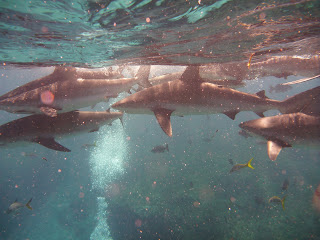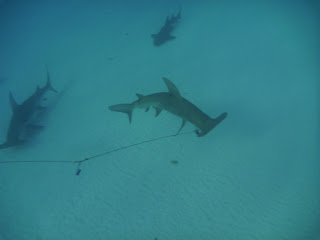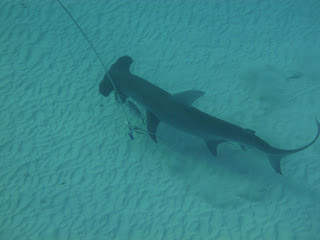So we left off yesterday around 11 am. We got back from the shark dive and the film crew went off to find some dolphins or some shit. Everyone knows dolphins are just gay sharks, so we weren't all that interested. The day before yesterday, two other volunteers and myself were tasked with chopping up bait for various activities. Four hours of that was enough to make a pair of shorts permanent bait-cutting shorts and force me to make some adjustments to the facial hair. Some bait splattered up onto the mustache and it was all I could smell so I decided to remove some. The end result looks something like if Wolverene were 100% Irish. Anyways, the three of us were rewarded by going out to bait for hammerheads to try to get some good shots for the film crew. It is still very early in the hammerhead season so we were not too optimistic. After a few hours, we finally had a visitor.
Lindsay was in the water scraping (holding a large piece of bait and consistently scraping down the fish to create a steady scent trail that the sharks can follow back to the boat) when she looked up and said, "There's a shark down there." We get excited and start putting on our fins and such to jump in when she comes back up and tells us it's just a nurse shark. It took the wind out of our sails a bit because nurse sharks are pretty boring. They can grow up to 14 feet long and are essentially harmless to people. They are almost always found just resting on the sea floor; they are one of a handful of sharks that can pump water through their gills without swimming. Not so exciting. But as Derek and I are about to get out of the water, Lindsay looks up and whispers, "There's a hammerhead down there." I had a much more enthusiastic reaction, after I looked down and saw this...
I looked up and yelled, "HOLY FUCK, there's a hammerhead down there!!"
This is the second post about hammerheads but I realize that I didn't really give the little briefing on the species like I have with the other ones. There are a few types of hammerheads, the one shown here and in the one in the earlier post are both Great hammerheads. These sharks are just magnificent, capable of growing up to 20 feet long and sporting one of the most unique and recognizable body shapes in the animal kingdom. Not only the shape of the head, but also the ridiculously tall dorsal fin. It is for this reason that Great hammerheads are listed as endangered. In many parts of the world, most notably Asia, sharks are killed by the tens of millions every year just for their fins. Having such large fins makes Great hammerheads ideal targets for shark finning.
Fishermen land the sharks, cut off all their fins, and then throw the body back into the water. Usually the shark is still alive at this point and either bleeds to death or suffocates because it cannot swim to keep water flowing through its gills. While it is estimated that populations of Great hammerheads have dropped 50% in the Western Atlantic, 73% in the Indian Ocean, and over 80% in Western Africa, there have been only 37 recorded attacks on humans by Great hammerheads, only 1 of which was fatal. Once again, that's 1 recorded fatality since the creation of the International Shark Attack File during World War II (the number of attacks and fatalities you see in this blog come from this source).
But enough of that depressing stuff, back to the awesome day yesterday. We called in the film crew so they could try to get some shots of our new friend, who was about 10 feet long. But before they could get there, he grabbed one of the baits and started "hammering the nail", thrashing his head back and forth until he ripped through the line and swam off with his prize. We thought that was the end of it, reveling in the fact that we got to witness a very rare shark. We were very, very wrong.
At this point, it was around 5:30, starting to get dark, when out of that deep, deep blue came first the original hammerhead, then a second, slightly smaller one, and finally the nurse shark from the beginning bringing up the rear. We were anchored in about 20 feet of water, so these guys came in nice and close to smile for our respective cameras. When we set out from the dock, Jim, the lab manager, said that best case scenario was that we would get a hammerhead to stick around for maybe 15 minutes. We were in the water with these two for 45 minutes, until it was almost too dark to see anymore. It capped a day that I will remember for the rest of my life as one of the best. I'll leave you with some of my favorite pictures. If you would like to see more, I have about 50 as well as a couple of videos, just let me know and I'll shoot them to you. There is a short clip at the end of this post, but I have a 3-minute gem of all 3 sharks. If you would like to see it, let me know and I will try to upload it to Youtube. Stay sharky kids.
Thursday, February 10, 2011
Wednesday, February 9, 2011
A Tale of Two Tales: Part I
So today was sort of epic. I got my underwater camera 2 days ago and it immediately paid dividends. The past few days there has been a French film crew at the lab, so today we tried to do all the fun stuff so we could get them some good footage. Part one of this segment is dedicated to the morning shark dive, which the new volunteers did 2 weeks ago and were able to do again because the film crew wanted us in the shot. This was the result.

This shot has all Caribbean reef sharks, but there were also some black-nosed sharks around as well. Caribbean reef sharks can get up to 10 feet long, but these guys ranged from 5-7 feet. The first time out, someone counted 12 sharks on the dive, but today was even more, the count reaching 16. People who have been at the lab for years were saying that was the most they'd seen and started saying the film crew was a good luck charm. We'll have more on that in part 2.
I practically dropped on top of this one and he just went about his merry way. I got a sweet video swimming behind it for about 30 seconds but it takes a ridiculously long time to upload and I'm tired and it's late and I have to go running tomorrow. But get excited, because part II of this day made it probably the greatest day of my life. To be concluded...

This shot has all Caribbean reef sharks, but there were also some black-nosed sharks around as well. Caribbean reef sharks can get up to 10 feet long, but these guys ranged from 5-7 feet. The first time out, someone counted 12 sharks on the dive, but today was even more, the count reaching 16. People who have been at the lab for years were saying that was the most they'd seen and started saying the film crew was a good luck charm. We'll have more on that in part 2.
Anyways, Caribbean reef sharks inhabit the tropical waters from Florida down to Brazil and sometimes Bermuda. They are listed as near threatened because they are overished in many areas and suffer the effects of coral reef degredation in others. As far as human attacks go, there are only 27 recorded attacks all-time, world-wide attributed to Caribbean reef sharks and none have been fatal.
The sharks that you see here have been "trained" by the lab over the course of about 20 years. They recognize the sound of our boat engines and gather together to get fed. We are always very careful to do exactly the same thing every time we put people in the water here. Everyone is strung out in a line holding a rope, shoulder to shoulder with no space in between. The staff throws bait a few feet in front of the rope and the sharks feed as they please. If a shark gets too close to us, we give them a good kick and they back off immediately. This deliniates our space from their space and this video shows that for the most part the sharks respect that.
As you can see, the sharks mostly stay out about 5-10 feet in front of us. Even when they come in close, just one kick will send them on their way. They don't get mad and turn around and bite everything in site. They do actually get into what is widely known as a "feeding frenzy" but they don't include people in that party. As soon as the staff stops throwing bait into the water, the sharks relax and just cruise around and we can drop off the line and swim with them for a bit. You can actually get really really close at this point because the water is only about 20 feet deep so it is pretty easy to dive down and swim around with individual sharks like this guy.
It might look fake, but my camera is awesome. You can't tell because of camera limitations but I was only about 2 feet behind this one and he just swam like I wasn't even there.
Thursday, February 3, 2011
The Longest Line
So I decided that I would only post when something cool happens. The day-to-day stuff here is kinda dry for most audiences so I'll just keep it to things that have pictures attached that will get people's attention, like this one.
That is a 10.5 foot tiger shark that was caught on the long lines that we set yesterday afternoon. A long line is basically a really long rope with floaters attached at intervals with hooks hanging off them. Add some bait to the hooks and you have a long line. Here, we generally set the lines at 2 pm, then check every 4 and a half hours or so. Usually there are 6 people in the setting and hauling crew, then 5 in the checking crews. Checkers go out at 6 pm, 9 pm, 1:30 am, 6 am, 10:30 am and then the haul at 2 pm the next day. The schedule is a bit tough for the 1:30 crew, but most sharks are nocturnal hunters so the 9 pm and 1:30 am checks usually have the most sharks.
This was the setting crew. There were a few stumbles at first but it was the first time for all of us so it's to be expected. And we caught this spectacular tiger shark, so clearly we're awesome setters.
Anyways, after the 9:00 crew secured her and did their sciency thing they called back to the lab to get everyone out there for pictures and a quick snorkle. Let me tell you, the first look at that face underwater stopped my breathe in my lungs. This next shot gives you a bit of perspective on how big this shark was.
A bit about tiger sharks. Tigers can grow to over 16 feet long, but usually top out at around 10-12 feet. So this girl was a big one. They can also weigh up to 1,400 lbs. I'm lifting with all my strength here and I barely got her dorsal fin (the one on top that I'm holding) out of the water. Moral of the story, this is a big shark. That being said, people have the idea that they are deadly anytime you get in the water with them, which is entirely false. You can count on two hands how many tiger shark attacks happen per year worldwide, which is an almost irrelevantly small number considering how many people swim in the ocean everyday. Obviously you don't want to just jump in the water with one if you don't know what you're doing, but they're not out to kill all humans. Even though we had it tied to the boat, this one never tried to thrash out or take a bite at any of us in the water and we got to within about a foot or so of her mouth.
After we all swam with her, the crew removed the hook and the tail-rope (exactly what it sounds like) and the shark calmly swam off into the night. We caught a few more overnight (not me, I was on the 10:30 and hauling crews, which rarely get any) but none were big enough to get everyone out of bed. We do this once a month, so look for another long-lining segment around this time in March. Hopefully we'll get some different species and I can expand your education. I have some pretty sweet shots of some baby lemon sharks so maybe my next post will deal with them.
That is a 10.5 foot tiger shark that was caught on the long lines that we set yesterday afternoon. A long line is basically a really long rope with floaters attached at intervals with hooks hanging off them. Add some bait to the hooks and you have a long line. Here, we generally set the lines at 2 pm, then check every 4 and a half hours or so. Usually there are 6 people in the setting and hauling crew, then 5 in the checking crews. Checkers go out at 6 pm, 9 pm, 1:30 am, 6 am, 10:30 am and then the haul at 2 pm the next day. The schedule is a bit tough for the 1:30 crew, but most sharks are nocturnal hunters so the 9 pm and 1:30 am checks usually have the most sharks.
This was the setting crew. There were a few stumbles at first but it was the first time for all of us so it's to be expected. And we caught this spectacular tiger shark, so clearly we're awesome setters.
Anyways, after the 9:00 crew secured her and did their sciency thing they called back to the lab to get everyone out there for pictures and a quick snorkle. Let me tell you, the first look at that face underwater stopped my breathe in my lungs. This next shot gives you a bit of perspective on how big this shark was.
A bit about tiger sharks. Tigers can grow to over 16 feet long, but usually top out at around 10-12 feet. So this girl was a big one. They can also weigh up to 1,400 lbs. I'm lifting with all my strength here and I barely got her dorsal fin (the one on top that I'm holding) out of the water. Moral of the story, this is a big shark. That being said, people have the idea that they are deadly anytime you get in the water with them, which is entirely false. You can count on two hands how many tiger shark attacks happen per year worldwide, which is an almost irrelevantly small number considering how many people swim in the ocean everyday. Obviously you don't want to just jump in the water with one if you don't know what you're doing, but they're not out to kill all humans. Even though we had it tied to the boat, this one never tried to thrash out or take a bite at any of us in the water and we got to within about a foot or so of her mouth.
After we all swam with her, the crew removed the hook and the tail-rope (exactly what it sounds like) and the shark calmly swam off into the night. We caught a few more overnight (not me, I was on the 10:30 and hauling crews, which rarely get any) but none were big enough to get everyone out of bed. We do this once a month, so look for another long-lining segment around this time in March. Hopefully we'll get some different species and I can expand your education. I have some pretty sweet shots of some baby lemon sharks so maybe my next post will deal with them.
Subscribe to:
Comments (Atom)













